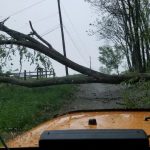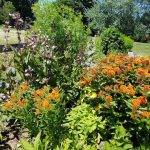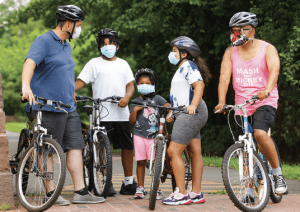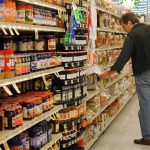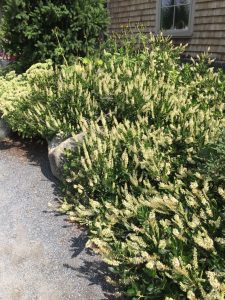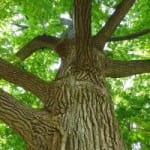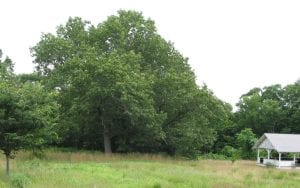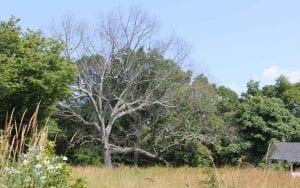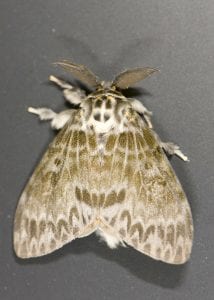
Ask UConn Extension
Common Questions and Answers You Can Trust
If you have a question for us, chances are someone else has the same one. Our professionals have curated some of our frequently asked questions to get you answers faster. Still have questions? Fill out our Ask UConn Extension form and we will get you an answer.
Climate Adaptation & Resiliency
Could our dry summer have contributed to tree damage during Tropical Storm Isaias?
Could our dry summer have contributed to tree damage during Tropical Storm Isaias?
It is unlikely that tree damage was exacerbated during Tropical Storm Isaias by summer dryness. On the contrary, had the soil been saturated with water, I expect we would have seen much more uprooting damage than we did.
Some damage in severe winds is simply unavoidable. Our research has indicated trees that achieve “resonance” with the wind, in terms of sway frequency, are likely to fail. (Think of that old film we all saw in school of the Tacoma Narrows Bridge failure). Some gusts are simply too strong for any tree to withstand.
But much of the tree failure we see is a function of forest and tree conditions. Trees, especially those growing along roadsides are often growing under very stressful and crowded conditions and are not considered the most robust and storm-resistant specimens we might describe. Much of the damage we observe comes back to being a forest management issue that requires the collective will and cooperation of the utilities, towns, and property owners to address.
Learn More
Extension Professional
Tom WorthleyExtension Associate Extension Professor, Forestry Program, Forest Sustainability Tom Worthley is Associate Extension Professor at UConn College of Agriculture, Health, and Natural Resources and the Department of Natural Resources and the Environment. He has written a number of scholarly articles and also teaches courses in Forest Ecology and Management and Dendrology. He has worked extensively on tracts in the UConn Forest and beyond in both outreach and educational activities. |
How do I get my water tested?
How do I get my water tested?
If you have “city water”, your supplier is required to test your water on a regular basis (check your water company website or call for specific information). If you have a private well, it is up to you to have the water tested! It is a good idea to have your water tested on a regular basis to detect any changes in quality. A standard potability test can be performed at many state-certified lab. Additional information can be found in this CT Dept. of Public Health Publication on Private Well Water.
Learn More
Extension Professional
Mike Dietz, Ph.D.Extension Professional Dr. Mike Dietz is an Associate Extension Professional for UConn Extension. Mike oversees the Connecticut Nonpoint Education for Municipal Officials (NEMO) program, in the Center for Land Use Education and Research (CLEAR). He has a Ph.D. in Water Resources from the University of Connecticut, and his extension and research programs focus on protecting surface waters, with a focus on green infrastructure techniques. |
How do I keep my pond healthy?
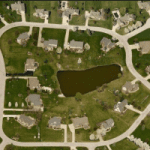 How do I keep my pond healthy?
How do I keep my pond healthy?
In general, to keep a pond healthy, the best thing you can do is be careful what you do in the area that drains to the pond. This means avoiding lawn fertilizer (regular or organic- both can cause problems in the water) and keeping a good buffer of vegetation around the area if possible. Also, watch out for road drainage which can add salts in the winter months.
Learn More
Extension Professional
Mike Dietz, Ph.D.Extension Professional Dr. Mike Dietz is an Associate Extension Professional for UConn Extension. Mike oversees the Connecticut Nonpoint Education for Municipal Officials (NEMO) program, in the Center for Land Use Education and Research (CLEAR). He has a Ph.D. in Water Resources from the University of Connecticut, and his extension and research programs focus on protecting surface waters, with a focus on green infrastructure techniques. |
I’m interested in engaging in local environmental stewardship efforts, but have no idea where to start and who to partner with. Where can I get resources?
I'm interested in engaging in local environmental stewardship efforts, but have no idea where to start and who to partner with. Where can I get resources?
Learn about conservation projects done by teens and community partners throughout the state, learn about best practices when working with youth or community partners on a project, and use these project development guides and templates to develop a conservation project.
Learn More
Extension Professional
Laura CisnerosAssistant Extension Professor, Department of Natural Resources and the Environment My extension efforts focus on promoting environmental action and civic participation in addressing local conservation issues by diverse participants (e.g. teens, adult community volunteers, and teachers). Through UConn’s Natural Resources Conservation Academy (NRCA; www.nrca.uconn.edu), I develop and implement experiential, place-based environmental learning opportunities that integrate tools and technology used by professionals and support intergenerational (e.g., teen & adult teams) community conservation projects. My integrated research efforts center on understanding how environmental action programs and citizen science impact student achievement, develop informed & engaged citizens, and expand capacity to address environmental issues. |
Soil-biodegradable plastic mulch: Is it right for you?
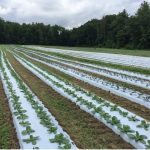
Soil-biodegradable plastic mulch: Is it right for you?
Agricultural Producers, something important for you to consider: your use of plastic mulch in vegetable production. This is especially worthy to think about given that plastic mulch isn’t just for tomatoes, peppers, and eggplant anymore. Most small-scale growers use it for onions, lettuce, herbs, and more. You’ve no doubt heard about biodegradable mulch, but possibly not so great things. Here are some important questions you may have, and some real answers.
Learn More
Extension Professional
Shuresh Ghimire, Ph.D.Assistant Extension Professional, Vegetable Crops Shuresh obtained his bachelor’s and master’s degree in agricultural science from Tribhuvan University in Nepal. He completed his Ph.D. in Horticulture (2015-2018) from Washington State University where he studied biodegradable plastic mulches for vegetable production. Prior to working in Washington, Shuresh was a Horticultural Development Officer for the Department of Agriculture in Nepal (2010-2015), where worked extensively with farmers conducting training and plant clinics and created extension publications. Shuresh also served as an Adjunct Assistant Professor of Horticulture at the Himalayan College of Agricultural Sciences and Technology in Nepal. In addition to working as a vegetable educator at UConn (since 2018), when hemp became a regulated agricultural crop in CT, he started working with hemp growers to create and disseminate information regarding hemp production practices and IPM. |
What are important considerations for plant selection designing a sustainable landscape?
What are important considerations for plant selection designing a sustainable landscape?
Proper plant selection is the most important step in designing a sustainable landscape.
- “Right plant, right place” is the fundamental principle for the environmentally sound management of landscapes. Plants should be selected for not only aesthetic value, but also because they are adapted to the existing soil conditions, available water, microclimate, and space available.
- Biologically diverse plants should be selected to tolerate reduced irrigation (once established), fertilizer, and soil amendment inputs.
- Establishing strong, healthy, vigorous plantings is crucial for pest management in sustainable landscapes. A vigorous, healthy, unstressed plant can usually survive, avoid, or outcompete many potential disease, insect, and weed pests without further intervention.
- Native plants are best adapted to the local soils and site conditions. Incorporating native plants helps to restore local ecosystems that support a wide variety of indigenous and beneficial insect, bird, and animal species. Over time, as these native plants become established, they can increase biodiversity and contribute to a reduction in expense and time spent on maintenance.
- A healthy and diverse landscape supports naturally occurring beneficial insects. Native predators and parasitoids will help control harmful pests when provided the opportunity and necessary habitat for their survival. Many practices that support pollinators also support pest-controlling insects.
Learn More
Extension Professional
Vickie WallaceUConn Extension Vickie Wallace is the Extension Professional responsible for the Sustainable Turf and Landscape Program focused toward turf and landscape professionals in the state. She is involved with IPM education and outreach programs for landscape professionals and municipal turf and grounds managers. A current focus is directed toward the ongoing installation of weather stations to schools across Connecticut, and subsequent educational outreach of these weather stations into general school grounds and turf care programs. She also is involved with the evaluation of low maintenance turfgrasses and the evaluation and efficacy of minimum risk weed management products. Prior to joining UConn in 2010, Ms. Wallace worked as an agronomist and sales representative in the turfgrass seed industry. Alyssa Siegel-MilesEducational Program Assistant 1 |
What is biodegradable mulch?
Health & Wellness
Can walking trails improve your health and fitness?
Can walking trails improve your health and fitness?
There are several types of trails that you can check out on your health journey, whether you are just beginning or experienced. Although it seems so basic, walking is the best exercise.
Click here to read about the health benefits of waking and find trail walking suggestions.
Learn More
Extension Professional
Umekia R. TaylorAssociate Extension Professional, EFNEP Supervisor Ms. Taylor is an Educator with UConn Extension for New Haven County as well as the supervisor of the Expanded Food and Nutrition Education Program (EFNEP). Ms. Taylor has over 25 years of experience with community nutrition. Her areas of expertise include wellness, exercise, and minority health issues. Ms. Taylor has worked with families and children to help improve nutrition through non-formal education. Ms. Taylor’s projects have included working with urban youth via community gardening and technology. She also has experience as a Trainer of Facilitators via the Academy of Educational Development/Center for Youth Development and Policy Research. |
How do I improve my bone health?
How do I improve my bone health?
There are many nutrients that are important to bone health, but two of the most important are calcium and vitamin D. A good diet is one of the building blocks for healthy bones, which also includes exercise and avoiding certain risk factors for falls. Poor bone health over many years can cause conditions such as osteoporosis and increase the risk of bones breaking from a fall1. In general, the Recommended Dietary Allowance (RDA) of calcium for adults is 1,000mg to 1,200mg of calcium per day2. That would be equal to 3-4 eight-ounce servings of milk or yogurt. This mineral isn’t made in our bodies therefore it must be supplied through dietary sources or calcium supplements. If there isn’t enough calcium in the bloodstream, then our body will start taking the nutrient from our bones. This could lead to weaker, thinner bones. While calcium is needed to keep bones healthy and strong, vitamin D is needed to help absorb the calcium in our intestine, and then into our bloodstream. Did you know your body can create vitamin D through your skin by sunlight?
Learn More
Extension Professional
Valerie Duffy, Ph.D.Professor, Department of Allied Health Sciences Dr. Valerie Duffy is a Professor and Director of the Graduate Program in the Department of Allied Health Sciences. She offers a wealth of experience in food, nutrition, health promotion, and public health nutrition. Her research program has two main areas fueled by extramural funding. First, her team aims to understand sensory nutrition or the influence of variation in chemosensory perception on food flavor, food preference, and consumption. Recently, her team has translated sensory nutrition into individualized dietary recommendations for children and adults through online survey and tailored nutrition messages. |
I found a tick on my animal. How can I get it tested for diseases?
I found a tick on my animal. How can I get it tested for diseases?
The Connecticut Veterinary Medical Diagnostic Laboratory (CVMDL) at UConn can test the tick for pathogens. Ticks received at the CVMDL are first examined and identified by trained technicians using a dissection microscope. This identification process determines the species of tick, life stage, and degree of blood engorgement, all of which are factors that may impact transmission of pathogens to the person or animal (the host). Ticks may then be tested for the DNA of pathogens that are known to be transmitted by that tick species. Results are reported within 3-5 business days of receiving the sample. Next business day RUSH testing is available for an additional fee. The information obtained from testing your tick at UConn is very useful when consulting with your physician or veterinarian about further actions you may need to take.
Learn More
Extension Professional
Guillermo Risatti, MS, DVM, Ph.D.Assistant Professor, Department of Pathobiology Dr. Guillermo R. Risatti is an Associate Professor of Pathobiology and Veterinary Science at the University of Connecticut. He received a Degree in Veterinary Medicine from Universidad Nacional de Río Cuarto, Argentina in 1987, a M.S. and Ph.D. degrees in Virology from the University of Nebraska, Lincoln, NE, in 1995 and 2000, respectively. From 1999 to 2004 he was a Post-Doctoral Fellow with the Exotic Viral Diseases Group at Plum Island Animal Disease Center, Greenport, NY. In 2004 he became Assistant Professor at the University of Connecticut and Associate Professor in 2010. Dr. Risatti also is a Senior Faculty Consultant for the Molecular Diagnostic Laboratory, at the Connecticut Veterinary Diagnostic Medical Laboratory, Storrs, CT. He has over 40 journal and conference publications, 6 awarded patents, and has contributed to 3 chapters to 2 books. As a virologist with extensive expertise on foreign animal diseases as relates to mechanisms of induction of disease, disease detection and disease protection, he is serving as consultant for the Defense Threat Reduction Agency (DTRA-US DoD) in two projects that focus of surveillance of African swine fever in the Republics of Georgia and Armenia. Since 2009 he has contributed to DTRA programs in the Caucasus Region focus on developing and providing training to veterinarians and veterinary diagnostic laboratory personnel in the Republics of Azerbaijan and Armenia that focused on detection of Especially Dangerous Pathogens (EDPs) working as consultant for DTRA through their Academic Engagement Partnerships at University of Illinois and Penn State University. His current research interest are on ASF and CSF mechanisms of host-virus interactions. Dr. Guillermo Risatti, in the Department of Pathobiology and Veterinary Science within the College of Agriculture, Health and Natural Resources, or CAHNR, has a multi-year working relationship with Dr. Maria Teresa Frias-Lepoureau from the Centro Nacional de Sanidad Agropecuaria (CENSA), in San Jose de las Lajas, Mayabeque, Cuba. Dr. Frias-Lepoureau is a researcher from Cuba working in the area of animal health, focused on the Classical Swine Fever Virus (CSFV), a devastating swine virus that has been eradicated from the US since 1978, but still impacts Cuban herds. |
I want to explore Connecticut trails, how do I find them?
 I want to explore Connecticut trails, how do I find them?
I want to explore Connecticut trails, how do I find them?
Connecticut’s bounty of natural areas, and the multi-use trails and hiking trails to explore them, are among of the state’s greatest assets for encouraging physical activity and recreation. The Department of Energy and Environmental Protection estimates that there are over 2,000 miles of multi-use trails within Connecticut State Parks and Forests alone, and the state’s famed Blue-Blazed Hiking Trails System, managed by the Connecticut Forest and Park Association includes more than 825 miles of volunteer managed hiking trails.
Answering the growing demand from the young workforce for alternatives to car-based transportation as well as the potential improvements to public health and community quality of life, Connecticut has invested millions of dollars in trail infrastructure.
The Connecticut Trail Census, a statewide trail data collection program, is launching its fourth year. The Census is a collaborative program with several statewide partners. Through this program, community-based volunteers collect data on how the state’s most popular multi-use trails are being used. The project is also currently developing plans for a statewide trail finder website. Resources about the Census and Trails Research are available at cttrailcensus.uconn.edu and cttrails.uconn.edu
Learn More
- State Park and Trail interactive map: http://bit.ly/CTInteractiveMap
- Blue Blazed Trails interactive map: http://bit.ly/BlueBlazed
- Trails 101 video series: https://cttrails.uconn.edu/trails101/
Extension Professional
Laura BrownLaura Brown - Extension Professional- Community Economic Development Laura Brown is a Community Economic Development Educator with UConn Extension and Certified Economic Developer (CED). Laura’s statewide work is focused on asset-based community, regional and economic development in urban communities. Prior to joining UConn in 2014, Laura served as an educator with the University of Wisconsin-Extension and the Hartford Food System. Laura holds a Master’s degree in Urban and Regional Planning from the University of Wisconsin-Madison and a Bachelor’s degree in Psychology and Communications from Clark University. |
What should I know before walking on a trail?
Food & Nutrition
How do I can or preserve my fruits and vegetables?
 How do I can or preserve my fruits and vegetables?
How do I can or preserve my fruits and vegetables?
It is important to learn and follow safe home food preservation methods. There are risks to almost every method, but canning, pickling, and fermentation carry some specific risks.
Here the Connecticut home food preserver will find links to information, methods, and recipes from sources that are based on science and have a reputation for researching recipes and methods to insure that they are safe for the home food preserver.
You may have some old favorite recipes that have been passed down over the generations. While some may be perfectly safe (particularly those for jams, jellies, and preserves), others may pose a greater health risk. By sticking to the methods and recipes provided here, you will be less likely to waste precious ingredients or make someone sick.
Keep in mind that your home preserved foods will likely not have the attributes of commercially preserved products. Sometimes that is good—jams and jellies taste fresher—and sometimes it is not—we do not have the ability to blast freeze our fruits and vegetables at home, so the quality cannot match what you buy from the grocery store freezer. It is important to have realistic expectations about home food preservation.
Learn More
Extension Professional
Indu Upadhyaya, Ph.D.Assistant Extension Professional, Food Safety Indu obtained her bachelor of veterinary science and animal husbandry (equivalent to DVM) and a master’s degree in veterinary biochemistry from Rajiv Gandhi Institute of Veterinary Education and Research in Pondicherry. She completed her PhD from UConn in Animal Science with a focus on Food safety and Microbiology. She moved to Arkansas as a postdoctoral associate at the University of Arkansas Center of Excellence for Poultry Science, where she worked in collaboration with the USDA Agricultural Research Service Poultry Production and Product Safety Research Unit. Before coming back to UConn as a faculty, she worked as an Assistant Professor in the School of Agriculture at Tennessee Tech University for one year. She was involved with developing a research program on poultry and fresh produce safety, including writing grants and collaborating with other faculty from various disciplines. She also taught two upper-level undergraduate courses and worked on various food safety outreach and recruitment activities in Tennessee. |
How do I keep food safe for me and my family?
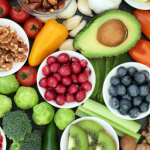 How do I keep food safe for me and my family?
How do I keep food safe for me and my family?
We all know that a dirty restaurant kitchen may put us at risk for foodborne illness. But do we apply the same rules to our home kitchens? What would a health inspector say if he checked your kitchen? To be sure that the food you make at home is safe, have the food safety tools you need, follow safe food handling procedures and make sure that your counters, work spaces and utensils are clean.
Food costs consume much of the family budget. So, it makes sense to consider the safety of food when you buy it and bring it home. You don't want to throw food out before you even use it.
Do your shopping in a store that looks clean, has quick turnover of perishable foods, and has a commitment to safe handling and display of produce, deli foods, meat and poultry. You will want a store that responds well to your concerns about safe food handling. And if you have concerns about a food product once you get it home, the store should not make it difficult to return the suspect item for a full refund.
Once you bring food home from the market, it is you who are now responsible for keeping it safe for you and your family. Storing food safely is the first step. We offer tips for the refrigerator, freezer, and pantry.
Learn More
Extension Professional
Indu Upadhyaya, Ph.D.Assistant Extension Professional, Food Safety Indu obtained her bachelor of veterinary science and animal husbandry (equivalent to DVM) and a master’s degree in veterinary biochemistry from Rajiv Gandhi Institute of Veterinary Education and Research in Pondicherry. She completed her PhD from UConn in Animal Science with a focus on Food safety and Microbiology. She moved to Arkansas as a postdoctoral associate at the University of Arkansas Center of Excellence for Poultry Science, where she worked in collaboration with the USDA Agricultural Research Service Poultry Production and Product Safety Research Unit. Before coming back to UConn as a faculty, she worked as an Assistant Professor in the School of Agriculture at Tennessee Tech University for one year. She was involved with developing a research program on poultry and fresh produce safety, including writing grants and collaborating with other faculty from various disciplines. She also taught two upper-level undergraduate courses and worked on various food safety outreach and recruitment activities in Tennessee. |
How long do I cook my food and how do I store it?
How long do I cook my food and how do I store it?
Dr. Indu Upadhyaya covers the best practices for cooking and storing meat including beef, chicken, and poultry.
Learn More
Extension Professional
Indu Upadhyaya, Ph.D.Assistant Extension Professional, Food Safety Indu obtained her bachelor of veterinary science and animal husbandry (equivalent to DVM) and a master’s degree in veterinary biochemistry from Rajiv Gandhi Institute of Veterinary Education and Research in Pondicherry. She completed her PhD from UConn in Animal Science with a focus on Food safety and Microbiology. She moved to Arkansas as a postdoctoral associate at the University of Arkansas Center of Excellence for Poultry Science, where she worked in collaboration with the USDA Agricultural Research Service Poultry Production and Product Safety Research Unit. Before coming back to UConn as a faculty, she worked as an Assistant Professor in the School of Agriculture at Tennessee Tech University for one year. She was involved with developing a research program on poultry and fresh produce safety, including writing grants and collaborating with other faculty from various disciplines. She also taught two upper-level undergraduate courses and worked on various food safety outreach and recruitment activities in Tennessee. |
How should I store and handle cheese?
 How should I store and handle cheese?
How should I store and handle cheese?
It is best to store all cheeses in their original unopened package in the refrigerator at <40°F. Be sure to wash your hands and any utensils before handling and try to avoid touching cheese you plan to put back in the refrigerator. It is best to keep cheeses in their original package, especially sliced or shredded cheese. Don’t put your hand directly into the bag either- pour shreds out or use a clean utensil to remove slices or shreds. Tightly wrap or seal the cheese (or the original packaging) before putting it back in the refrigerator. You can also place the wrapped cheese in an airtight container if you have one. You can take cheese out of the refrigerator to come to room temperature before you plan on eating it but don’t leave it out for too long as the texture will change and fats may seep out as oil on the outside. Place any leftover cheese back in the refrigerator as soon as you’re done.
Learn More
Extension Professional
Dennis D'Amico, Ph.D.Associate Professor, Department of Animal Science Dennis D’Amico is a trained food scientist with expertise in food microbiology and safety. Prior to joining UConn he was a founding member of the Vermont Institute for Artisan Cheese (2004-13) where he served as Senior Research Scientist and Lecturer. Dennis has established an active and collaborative research program at UConn externally funded by more than a dozen grants from a variety of sources including the USDA, industry groups, and several foundations. He has published more than 50 scholarly manuscripts, book chapters, and abstracts and has delivered more than 20 invited talks at regional, national, and international conferences. |
How should I store oil to prevent spoilage?
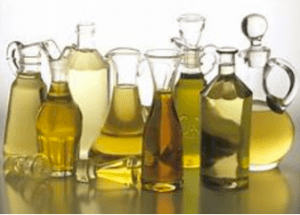 How should I store and handle oils?
How should I store and handle oils?
Unsaturated fats such as olive, vegetable, and canola oils are cooking staples in many households. These oils often sit on our shelves, ready to be used in our recipes and delicious dishes. They seem to last forever, right? To the contrary, if not stored properly, oils may go rancid.
Rancidity is the deterioration of fats and oils that causes unpleasant odors and less than desirable flavors1. This can occur from exposure to certain microbes as a result of poor food handling and hygiene1. More often oil rancidity occurs when oil is exposed to oxygen resulting in the formation of free radicals1. These free radicals contribute to the change in taste and smell of cooking oils. Despite the decrease in quality, rancid oil does not generally make a person sick if consumed1.
Many environmental elements in the household can cause oils to develop these free radicals:
Light- Sunlight or light from lamps support the production of free radicals1, 2.
Temperature- Higher temperatures increase the rate at which oil oxidizes2.
Time- Regardless of external factors, oil will go rancid eventually. It is good to use it in a timely manner. Opened containers of oil are best if used within 2-3 months while unopened oil is good for up to 4 months3.
Air- Make sure to place the cap back on the container tightly between uses1,2.
Keep your oil off the countertop and in a dark, dry location at room temperature. This will reduce the amount of light, heat, and air that increase the rate of rancidity described above1,2. It will also preserve the taste and smell. Additionally, purchase your oil packaged in dark or tinted containers. Make sure to not refrigerate your oils; moisture will also increase the rate of rancidity.
The oils we use most often fall into two categories of unsaturated fats. Monounsaturated fatty acids are found in olive, canola, and sunflower oils4. Polyunsaturated fatty acids are found in sunflower, soybean, and cottonseed oils4. Both decrease the risk of heart disease and stroke by reducing the levels of LDL, or “bad” cholesterol in the blood4,5. Omega-3 fatty acids specifically promote heart health by lowering blood pressure and risks of blood clots4.Olive oil is known to have one of the highest levels of monounsaturated fats5.
Learn More
Extension Professional
Valerie Duffy, Ph.D.Professor, Department of Allied Health Sciences Dr. Valerie Duffy is a Professor and Director of the Graduate Program in the Department of Allied Health Sciences. She offers a wealth of experience in food, nutrition, health promotion, and public health nutrition. Her research program has two main areas fueled by extramural funding. First, her team aims to understand sensory nutrition or the influence of variation in chemosensory perception on food flavor, food preference, and consumption. Recently, her team has translated sensory nutrition into individualized dietary recommendations for children and adults through online survey and tailored nutrition messages. |
Is my tap water safe to drink?
 Is my tap water safe to drink?
Is my tap water safe to drink?
It is a good idea to have your water tested on a regular basis to detect any changes in quality.
Click here to view Dr. Mike Dietz's response and suggestions (scroll down to the second question).
Learn More
Extension Professional
Michael DietzPh.D. | Extension Professional, Water Resources (860) 486-2436 Dr. Mike Dietz is an Associate Extension Professional for UConn Extension. Mike oversees the Connecticut Nonpoint Education for Municipal Officials (NEMO) program, in the Center for Land Use Education and Research (CLEAR). He has a Ph.D. in Water Resources from the University of Connecticut, and his extension and research programs focus on protecting surface waters, with a focus on green infrastructure techniques. |
What are some healthy snacks that everyone will eat?
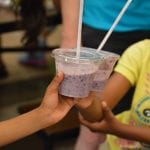 What are some healthy snacks that everyone will eat?
What are some healthy snacks that everyone will eat?
UConn Expanded Food and Nutrition Education Program (EFNEP) is here to lead you in the right direction!
Click here to view healthy snack suggestions.
Learn More
Extension Professional
Erica BenvenutiRD | Community Nutrition Professional, UConn Extension Erica Benvenuti provides Nutrition Education in New London County to families and children. Using up to date materials and information to guide her groups in making healthier, budget-conscious choices in their daily lives. Groups are held in schools, social service agencies, food pantries, churches, libraries, and a variety of other settings. |
What do the food labels “Organic,” “Natural,” and “Non-GMO” actually mean?
What do the food labels “Organic,” “Natural,” and “Non-GMO” actually mean?
The organic, natural, and non-GMO food marketing labels differ in terms of what they mean and whether they are certified and inspected by government agencies.
Click here to view a breakdown of all these confusing food marketing labels.
Learn More
Extension Professional
Cristina ConnollyAssistant Professor, Agricultural and Resource Economics |
How do I clean high touch surfaces?
How do I clean high touch surfaces?
How do you keep your high touch surfaces clean? We explain the best way to disinfect, and all of the surfaces you should consider.
Learn More
Extension Professional
Mary Ellen WelchExtension Educator, Family and Consumer Science |
How do I know if there is Sesame in my Food?
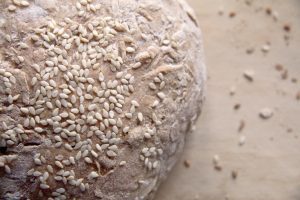 How do I know if there is Sesame in my Food?
How do I know if there is Sesame in my Food?
As of January 1, 2023, Sesame is now required to be labeled as an allergen on packaged foods, including dietary supplements. This has been the culmination of efforts for years among food allergy advocates. Sesame is now the country’s ninth major allergen, affecting approximately 1.6 million people (about the population of West Virginia) in the United States. Cases of Sesame allergy, some quite severe, have been rising in recent years along with a growing number of foods that contain the ingredient. Dr. Michael Pistiner, Director of Food Allergy, Education and Prevention at Mass General Hospital for Children believes one reason for the rise in sesame allergies is due to more people in the United States eating sesame- containing products (2019).
Sesame can be found in obvious places like sesame seeds on bagels. But it is also an ingredient in many foods from ice cream, hummus to protein bars and can be added to sauces, dips and salad dressings and hidden in spices and flavorings. Because it is in a lot of foods as hidden ingredients, it is very hard to avoid.
The Food Allergy, Safety, Treatment, Education and Reasearch (FASTER) Act became law in April 2021, requiring sesame to be listed on packaged foods beginning January 1, 2023.
Learn More
Extension Professional
Sharon GrayExtension Professional, EFNEP |
Where can we get healthy food?
How do we eat healthy on a budget?
Home Gardening & Landscaping
Are native plants good for pollinators?
Are native plants good for pollinators?
In most cases cultivars of native plants are just as good at supporting pollinators as the straight species.
- Honeybee on Clethra alnifolia ‘Ruby Spice’.
- Landscape planting of Clethra alnifolia ‘Hummingbird’, which we found had more flowers and two times the pollinator visitation as the straight species.
https://doi.org/10.21273/HORTSCI14375-19
Novel native shrubs as replacements for invasive plants
There is increased interest in using native plant alternatives to invasive species for landscaping. While some native plants are commonly used, others with ornamental potential have yet to be developed. My research program is focused on the identification and development of novel native species as landscape plants to broaden the palette of native plants available to consumers. Some ornamental native species that I am interested in are Comptonia peregrina (Sweetfern), Corylus cornuta (Beaked filbert), Leucothoe racemosa (Sweetbells), Myrica gale (Sweetgale), Prunus pumila var.depressa (Eastern sandcherry), Rhus copallina (Shining sumac) and Spirea tomentosa (Steeplebush). These species exhibit wide adaptability in natural settings making them prime candidates for development as native landscape plant alternatives for difficult sites. I am evaluating these plants for their adaptability to different landscape sites and conducting research to optimize crop production protocols for these species.
Learn More
Extension Professional
Jessica Lubell BrandAssociate Professor, Department of Plant Science and Landscape Architecture |
Can someone identify this bug I found in my house/yard/garden?
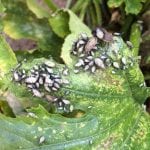 Can someone identify this bug I found in my house/yard/garden?
Can someone identify this bug I found in my house/yard/garden?
We have nine statewide Master Gardener locations, and the Home and Garden Education Center at the UConn-Storrs campus available to help you identify an insect. You can either email us a photo, or you can stop in and visit.
- Find a Master Gardener location near you at: mastergardener.uconn.edu
- Submit your question online at: mastergardener.uconn.edu/ask-us-a-question/
- Or visit our Home and Garden Education Center in Storrs at: homegarden.cahnr.uconn.edu
Learn More
Extension Professional
Sarah BaileyProgram Coordinator, Master Gardeners |
How can I get rid of black knot?
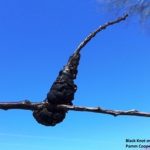 How can I get rid of black knot?
How can I get rid of black knot?
What is Black Knot?
Black Knot, is a disease commonly found on plums and Prunus species. The fungus causes the plant to produce unusual galls which eventually grow to girdle twigs and branches, restricting water supply and killing portions of the canopy. It is spread to other plants via wind and water.
Control
Manage the disease by carefully pruning away the affected tissue. Use sterile pruning tools to make a cut roughly 4 to 6 inches past the lowest point of symptoms on the branch. After cutting the branch, sterilize the tools again by dipping them in a 10% bleach solution (1 part bleach, 9 parts water -> e.g. 1/2 cup bleach, 4 & 1/2 cups water). You should also spray a bit of this bleach solution on the cut wound on the tree. Repeat this process until all the black growth has been removed. Burn the branches and do not compost them. Prune during dry weather to prevent the spread of the disease. This can be done in the fall and winter if the fruit is still growing on affected branches. The client may need to repeat this process every winter for the rest of the tree's life or until symptoms no longer appear.
Learn More
Extension Professional
Dawn PettinelliAssociate Extension Professional Manages/coordinates activities of the UConn Home & Garden Education Center and the UConn Soil Nutrient Analysis Laboratory. |
How do I decide what kind of tree to plant?
How do I decide what kind of tree to plant?
There are several elements to consider when deciding what tree to plant and where to plant it.
What are they? Click here to find out (scroll down to the third question).
Learn More
Extension Specialist
Bob Ricard, Ph.D.Senior Extension Professional, Forestry Program, Tree Wardens, Extension Disaster Education Network Bob Ricard is Senior Extension Professional with the Department of Extension and teaches in the Department of Natural Resources and the Environment. He came to the University of Connecticut in 1991. Bob is responsible for helping Connecticut cities and towns with better managing public trees and forests focusing mostly on municipal tree wardens and community forestry volunteers. He also assists educators and researchers conduct social science research design and methods. He conducts the Tree Warden School and assists the Tree Wardens Association of Connecticut, Inc., which he formed in 1992. He is co-author, with Glenn Dreyer, of Greening Connecticut Cities and Towns: Managing Public Trees and Community Forests. Bob holds a Ph.D. in public policy with other degrees in forest resources. He is a Fellow of the Society of American Foresters. Dr. Ricard has also been recently appointed as the Coordinator for the UConn EDEN (Extension Disaster Education Network). Bob has a background in emergency medical response as well as instruction. He is a certified Wilderness First Responder and Whitewater Rescuer. He holds certifications as an American Heart Association (AHA) Basic Life Support (BLS) Instructor, AHA BLS Healthcare Providers, American Red Cross (ARC) CPR/AED Instructor, and ARC BLS for Professional Rescuers and Health Care Providers. He is affiliated with the Amherst (MA) C.E.R.T and with the Berkshire Mountain Search and Rescue Team. |
How do I get my soil tested?
How do I get my soil tested?
The UConn Soil Nutrient Analysis Lab does soil testing for a small fee.
- Have the test for home grounds and landscapers done.
- The directions for completing the test and sending in the sample are located on their website.
Learn More
Extension Professional
Dawn PettinelliAssociate Extension Professional Manages/coordinates activities of the UConn Home & Garden Education Center and the UConn Soil Nutrient Analysis Laboratory. |
How do I maintain my garden in a more sustainable way?
 How do I maintain my garden in a more sustainable way?
How do I maintain my garden in a more sustainable way?
- Perform a soil test when renovating both landscapes and turfgrass areas. Find instructions here. Consider the soil characteristics, climate, sun exposure, water conditions, and pest possibilities when selecting plants.
- Utilize native plants wherever possible, incorporating them into the landscape, along with annuals, to maintain season-long color and aesthetic interest. Native plants can be interplanted in existing landscapes, even among non-native plants.
- Group plants with similar watering, pH, fertilizer, and light requirements together to allow for the most efficient use of resources.
- Ensure that the mature height and width of each plant is factored into the landscape design to avoid the need for excessive pruning or regular replacement.
- Select more stress-tolerant species or cultivars to manage periodic dry/wet conditions. Where feasible, design with drought tolerant and low water use plants that require minimal irrigation. Where irrigation is necessary, utilize high-efficiency irrigation systems (e.g., drip irrigation) or recycled water features in all landscaped areas for maximum efficiency.
- Utilize a diverse range of plant species. Choose plants that offer ornamental interest in every season. Bark, foliage, fruit, and fragrance are ornamental characteristics to consider, in addition to flowers.
- Select flowers with a variety of colors, shapes, sizes, heights, and growth habits to attract pollinators. Choose plants with a wide range of flowering times to extend the forage season and attractiveness of the planting. Select plant material not regularly browsed by deer.
- Plant in "floral clumps,” which imitates the way plants naturally seed themselves and is both aesthetically pleasing and beneficial for pollinators. It is easier for pollinators to find and benefit from plantings when there are five or more of each pollinator-supporting species in a group.
- Consider including species that support both butterfly/moth larvae and adults. Many butterfly and moth species are highly specialized, requiring specific plants for their survival, especially for their larvae. For example, monarch caterpillars can only survive by consuming milkweed plants. Many trees, including oak, maple, and willow, also serve as butterfly/moth larval host plants. While larval host plants will endure some damage as insects or other wildlife consume their leaves, native plants can tolerate and thrive in balance with the native insects that depend on them for survival.
- For lawn areas, select improved and low-maintenance cultivars of turfgrasses suitable for home lawns, with improved drought tolerance and pest resistance. Consult UConn Extension educators. Several national programs evaluate turfgrasses, including National Turf Evaluation Program (NTEP), Alliance for Low Input Sustainable Turf (ALIST), and Turfgrass Water Conservation Association (TWCA). UConn serves as an evaluation site for reduced input or low maintenance turfgrasses.
Learn More
Extension Professional
Vickie WallaceUConn Extension Vickie Wallace is the Extension Educator responsible for the Sustainable Turf and Landscape Program focused toward turf and landscape professionals in the state. She is involved with IPM education and outreach programs for landscape professionals and municipal turf and grounds managers. A current focus is directed toward the ongoing installation of weather stations to schools across Connecticut, and subsequent educational outreach of these weather stations into general school grounds and turf care programs. She also is involved with the evaluation of low maintenance turfgrasses and the evaluation and efficacy of minimum risk weed management products. Prior to joining UConn in 2010, Ms. Wallace worked as an agronomist and sales representative in the turfgrass seed industry. Alyssa Siegel-MilesEducational Program Assistant 1 |
How often should I water my vegetable plot?
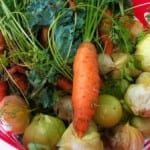 How often should I water my vegetable plot?
How often should I water my vegetable plot?
Deciding when to water (or irrigate) your vegetables should not rely on visual plant cues such as leaf curling or wilting. Before such symptoms appear, mild moisture stress could have affected plant health, potentially reducing the harvest. Shuresh talks about when and how much we should water our vegetable plants and why.
Click here to view (scroll down to the last question).
Learn More
Extension Professional
Shuresh Ghimire, Ph.D.Assistant Extension Professional, Vegetable Crops Shuresh obtained his bachelor’s and master’s degree in agricultural science from Tribhuvan University in Nepal. He completed his Ph.D. in Horticulture (2015-2018) from Washington State University where he studied biodegradable plastic mulches for vegetable production. Prior to working in Washington, Shuresh was a Horticultural Development Officer for the Department of Agriculture in Nepal (2010-2015), where worked extensively with farmers conducting training and plant clinics and created extension publications. Shuresh also served as an Adjunct Assistant Professor of Horticulture at the Himalayan College of Agricultural Sciences and Technology in Nepal. In addition to working as a vegetable educator at UConn (since 2018), when hemp became a regulated agricultural crop in CT, he started working with hemp growers to create and disseminate information regarding hemp production practices and IPM. |
Is my tree dead?
I have a tree on my property that failed to produce leaves last spring, is it dead?
The leaves on my tree all turned brown over the summer, is it dead?
“During the spring and summer of 2018, the impact of previous years’ drought, defoliation from the Gypsy Moth, and secondary opportunistic pathogens became apparent as tens of thousands of roadside trees throughout eastern Connecticut and thousands of acres of oak woodlands exhibited severe mortality.” - Tom Worthley, Extension Associate Extension Professor
If your tree did not produce leaves last season, it is most likely dead and won’t produce leaves next year. This mortality is likely the result of invasive exotic insect pests in combination with drought conditions.
- Trees that produced leaves this spring, but turned brown this summer have also died, due to secondary opportunistic pathogens taking advantage of stressed trees.
- Ash trees that are dead decay quickly. Small twigs and branches will start dropping immediately, with larger branches dropping over the next several months. Depending on lean, the trunk might drop any time during the coming year or two.
- Oak trees decay more slowly. Small twigs and branches will begin to drop this fall and winter, with larger branches dropping over the next year or two. The main trunk and limbs of oaks might retain some structural integrity for several years, but again, depending on lean, the trunk will tip over eventually as the root system rots away.
- Removing dead trees is dangerous. Without proper training and safety equipment, people are easily injured. Professional help is strongly encouraged. Near houses and structures, seek the help of an arborist. A listing can be found at the web site of the CT Tree Protective Association.
- Dead trees are dangerous. Please do not attempt to remove or harvest dead trees on your own without proper personal protective equipment (PPE) (chaps, hardhat, eye and ear protection), and appropriate chain saw safety training. There are no chain saw experts or professionals that do not use PPE.
- To address affect stands on forested lands, the help of a CT Certified Forester.pdf is suggested. Be patient and persistent. The problem of tree mortality in our area has arborists and forestry firms working at full capacity, and they’re likely to be fully booked for some time.
- If you are planning to use dead trees for firewood, please do not transport the wood to other states. Use it/burn it near where it has been harvested, to avoid spreading pests and pathogens.
Learn More
Extension Specialist
Tom WorthleyExtension Associate Extension Professor, Forestry Program, Forest Sustainability Tom Worthley is Associate Extension Professor at UConn College of Agriculture, Health, and Natural Resources and the Department of Natural Resources and the Environment. He has written a number of scholarly articles and also teaches courses in Forest Ecology and Management and Dendrology. He has worked extensively on tracts in the UConn Forest and beyond in both outreach and educational activities. |
My plant is sick. What is causing it? What should I do?
 My plant is sick. What is causing it? What should I do?
My plant is sick. What is causing it? What should I do?
We have nine statewide Master Gardener locations, and the Home and Garden Education Center at the UConn-Storrs campus available to help with your plant and gardening questions. You can either email us a photo, or you can stop in and visit with the plant specimen.
- Find a Master Gardener location near you at: mastergardener.uconn.edu
- Submit your question online at: mastergardener.uconn.edu/ask-us-a-question
- Or visit our Home and Garden Education Center in Storrs at: homegarden.cahnr.uconn.edu
Extension Professional
Sarah BaileyProgram Coordinator, Master Gardeners |
What are the squiggly things in my tomatoes?
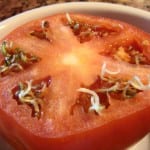 I just cut open a tomato and there are squiggly things inside. What are they?
I just cut open a tomato and there are squiggly things inside. What are they?
Have you ever cut into a tomato and found white squiggly looking things inside? These are not worms or aliens that made their way to the center, but rather seeds of the fruit that have begun germinating. It is called Vivipary, Latin for Live Birth. It is the term for plants that begin growing while still inside or attached to the mother plant. It is common in certain varieties of tomatoes, peppers, apple, pears, and some citrus.
This tomato probably was a bit older and sat on the counter for a while in a warm kitchen. Vivipary happens when the hormone controlling the seed dormancy is exhausted or runs out, letting the seed grow in the moist environment inside the fruit. This warm, moist environment is perfect for germinating seed to grow. If the tomato were left uncut in the warm conditions, the new plant sprout would eventually poke through skin of the now decomposing tomato.
Learn More
Extension Professional
Carol QuishProgram Assistant, UConn Home & Garden Education Center |
“What is the best way to mulch around my trees?”
What is the best way to mulch around my trees?
People also ask:
Should I mulch around my trees?
What is a tree volcano?
Mulch is useful at the base of a tree for many reasons. When done correctly, the mulch protects the tree from a lawnmower or string trimmer, aids in keeping the soil moist and keeps the ground cooler in the summer and warmer in the winter. Mulch also improves soil structure, aeration, and prevents soil erosion and runoff.
Tree Volcanos - A tree volcano is a landscaping technique of piling mulch in a cone or volcano-like shape around the base of a tree. While this may be aesthetically pleasing to some, in reality, it is devastating to the tree. Bark is the outermost protective layer or skin of a tree, to properly function, it needs to be exposed to air. If mulch is piled high around the trunk of the tree, the mulch softens the tree's bark and allows outside organisms like varmints, insects, bacteria, virus and fungi to penetrate into the tree. Over time a tree volcano will kill the tree.
Learn More
Extension Specialist
Bob Ricard, Ph.D.Senior Extension Professional, Forestry Program, Tree Wardens, Extension Disaster Education Network Bob Ricard is Senior Extension Professional with the Department of Extension and teaches in the Department of Natural Resources and the Environment. He came to the University of Connecticut in 1991. Bob is responsible for helping Connecticut cities and towns with better managing public trees and forests focusing mostly on municipal tree wardens and community forestry volunteers. He also assists educators and researchers conduct social science research design and methods. He conducts the Tree Warden School and assists the Tree Wardens Association of Connecticut, Inc., which he formed in 1992. He is co-author, with Glenn Dreyer, of Greening Connecticut Cities and Towns: Managing Public Trees and Community Forests. Bob holds a Ph.D. in public policy with other degrees in forest resources. He is a Fellow of the Society of American Foresters. Dr. Ricard has also been recently appointed as the Coordinator for the UConn EDEN (Extension Disaster Education Network). Bob has a background in emergency medical response as well as instruction. He is a certified Wilderness First Responder and Whitewater Rescuer. He holds certifications as an American Heart Association (AHA) Basic Life Support (BLS) Instructor, AHA BLS Healthcare Providers, American Red Cross (ARC) CPR/AED Instructor, and ARC BLS for Professional Rescuers and Health Care Providers. He is affiliated with the Amherst (MA) C.E.R.T and with the Berkshire Mountain Search and Rescue Team. |
What resources are available for commercial hemp producers?
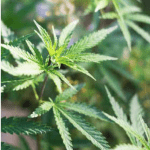 What resources are available for commercial hemp producers?
What resources are available for commercial hemp producers?
The UConn Hemp Extension and Outreach Program assists commercial hemp producers by providing information on production techniques and pest management. The program emphasizes healthy soils, balanced plant nutrition, pest identification, and preventative management strategies. The program offers training and field visits for hemp growers.
We have organized several meetings for hemp growers, including a workshop in 2019, and the 2020 Connecticut Hemp Conference in February with our partners at USDA NRCS and CT RC&D. The conference covered healthy soils practices, local policy and regulations, Connecticut field trial results, as well as innovative production markets. The event was a valuable resource for local producers and farmers who are seeking connections in the state as well as knowledge about local issues and opportunities.
Additional information about our Hemp Extension and Outreach, as well as research being done in CAHNR is available at: cannabis.cahnr.uconn.edu
Learn More
Extension Professional
Shuresh Ghimire, Ph.D.Assistant Extension Professional, Vegetable Crops Shuresh obtained his bachelor’s and master’s degree in agricultural science from Tribhuvan University in Nepal. He completed his Ph.D. in Horticulture (2015-2018) from Washington State University where he studied biodegradable plastic mulches for vegetable production. Prior to working in Washington, Shuresh was a Horticultural Development Officer for the Department of Agriculture in Nepal (2010-2015), where worked extensively with farmers conducting training and plant clinics and created extension publications. Shuresh also served as an Adjunct Assistant Professor of Horticulture at the Himalayan College of Agricultural Sciences and Technology in Nepal. In addition to working as a vegetable educator at UConn (since 2018), when hemp became a regulated agricultural crop in CT, he started working with hemp growers to create and disseminate information regarding hemp production practices and IPM. |
What should I do if I hear chainsaws in the forest?
"I hear chainsaws in the woods when I'm out there, what should I do?"
Tom Worthley, one of our Extension foresters, explains why chainsaw activity is needed in the UConn Forest and other forest management areas throughout the state.
Learn More
Extension Specialist
Tom WorthleyExtension Associate Extension Professor, Forestry Program, Forest Sustainability Tom Worthley is Associate Extension Professor at UConn College of Agriculture, Health, and Natural Resources and the Department of Natural Resources and the Environment. He has written a number of scholarly articles and also teaches courses in Forest Ecology and Management and Dendrology. He has worked extensively on tracts in the UConn Forest and beyond in both outreach and educational activities. |
Who can I contact about gypsy moth activity?
Who can I contact about gypsy moth activity?
How do gypsy moths affect trees?
Except in rare circumstances, such as what occurred in Eastern CT in 2016 and 2017, defoliation by gypsy moth caterpillars is a temporary and cyclical event. Population outbreaks of gypsy moth do occur periodically, when factors in the environment that generally keep the population stable are not quite in balance. Usually, healthy oaks and other hardwood trees can withstand an episode of defoliation, they will set new buds and produce a new set of leaves to finish out the growing season. The effect shows up as smaller than normal growth rings. Softwood trees such as pines and hemlocks can be killed, however, with a single defoliation.
Repeated defoliation events in subsequent years can be problematic because the carbohydrate reserves that trees need for refoliation can become exhausted. Also, if there are additional stress factors involved such as drought or other pests tree mortality can occur.
There is not much an individual can do except wait for the infestation to run its course and make sure individual trees get plenty of water.
Good information about the pest can be found at the web pages of the CT Agricultural Experiment Station (CAES). For advice about your specific parcel of forest land, you might also wish to contact the CT-DEEP Service Forester for your area.
Learn More
Extension Professional
Tom WorthleyExtension Associate Extension Professor, Forestry Program, Forest Sustainability Tom Worthley is Associate Extension Professor at UConn College of Agriculture, Health, and Natural Resources and the Department of Natural Resources and the Environment. He has written a number of scholarly articles and also teaches courses in Forest Ecology and Management and Dendrology. He has worked extensively on tracts in the UConn Forest and beyond in both outreach and educational activities. |
How do I use a soaker hose in my garden?
What is Integrated Pest Management?
What should I do if I hear chainsaws in the forest?
Extension Organization
How do I become a Master Gardener?
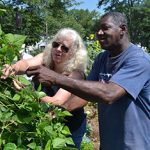 How do I become a Master Gardener?
How do I become a Master Gardener?
The UConn Extension Master Gardener Program is part of UConn Extension. The program started in 1978 and consists of horticulture training and an outreach component that focuses on the community at large.
To become a Certified Master Gardener you must complete a sixteen week course that meets once a week, starting in January and running through April. Students receive training in subjects including botany, plant pathology, soils, entomology, pesticide safety, integrated pest management (IPM), ornamental plants, vegetables, tree and small fruits, turf grass, weeds, environmental factors affecting plant growth, and diagnostic techniques for the home gardener.
Following formal classroom instruction the Master Gardener student completes a 60-hour internship program. Thirty hours are dedicated to hands-on training in the extension offices where students are supervised in researching and determining the answers to a broad range of horticultural questions, including insect and plant identification, diagnosing plant diseases and providing sound horticultural recommendations.
Students devote the remaining thirty hours to organized community outreach projects. The Master Gardener program also offers Garden Master Classes. For Certified Master Gardeners they provide continuing education as part of the Advanced Master Gardener certification process. These classes are also open to the general public. Anyone with an interest in gardening and horticulture is welcome! More information on the program and classes is available at mastergardener.uconn.edu.
Learn More
Extension Professional
Sarah BaileyProgram Coordinator, Master Gardeners |
How does my child or teen join 4-H?
4-H is open to any youth who is at least 5 years and not 19 years of age on January 1st of the calendar year.
- We have a special program for 5 and 6-year olds called CT Explorers. Please contact your local 4-H office to see if an Explorers club is available in your area.
- There is no charge to become a 4-H member. Interested youth should contact their local Extension Center. When you contact your local UConn 4-H office you will either be referred to an existing club leader, provided information on independent membership or the possibility of starting a group in their area will be explored.
- Registration as a 4-H member is completed through the 4-H Online Enrollment System.
Extension Professional
Nancy WilhelmProgram Administrator, UConn 4-H Nancy Wilhelm is the 4-H Program Administrator in the UConn Extension Storrs Office. She coordinates the selection process for 4-H award trips as well as multiple statewide 4-H events. She is also responsible for assisting 4-H clubs with the tax exemption process and compliance with minor protection guidelines. |
